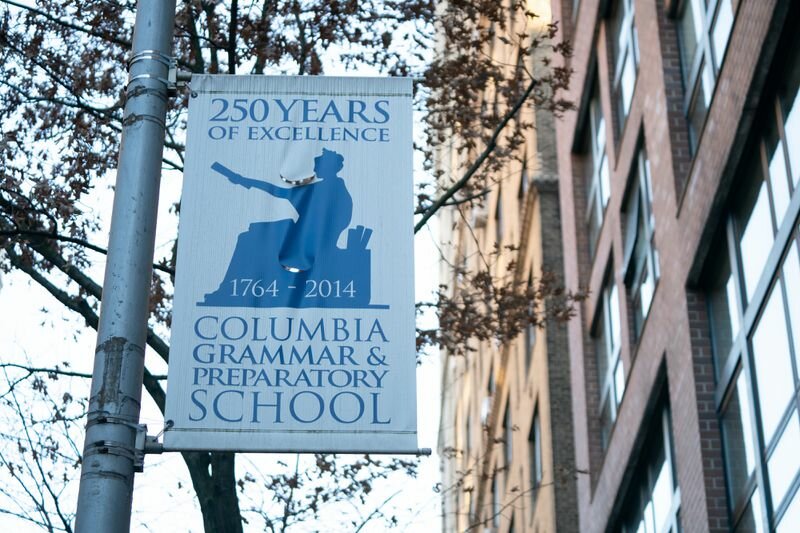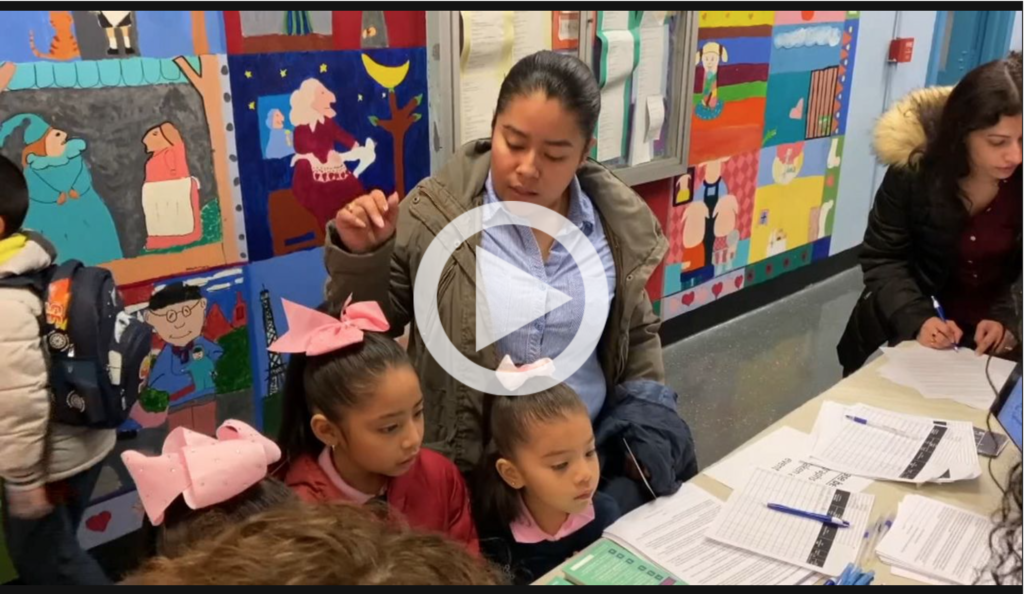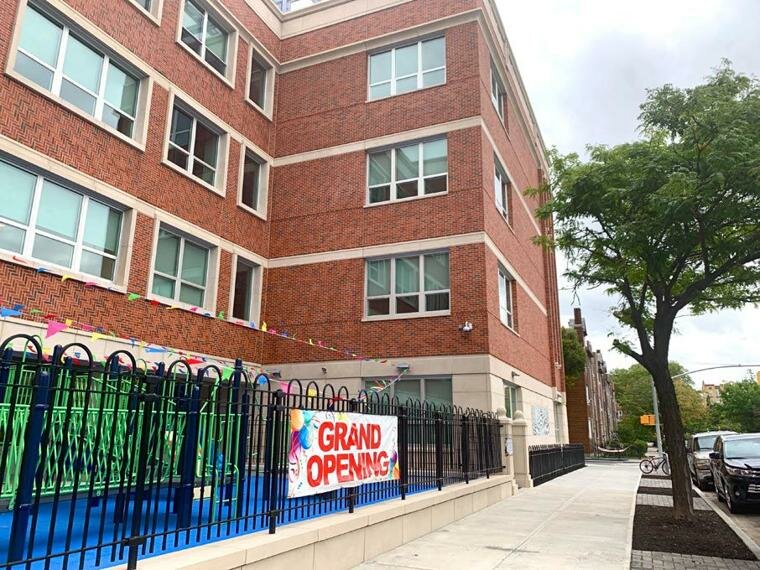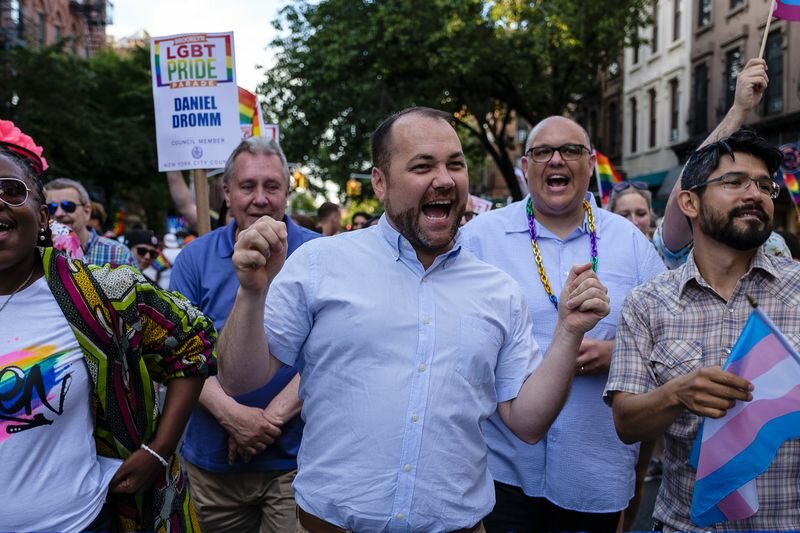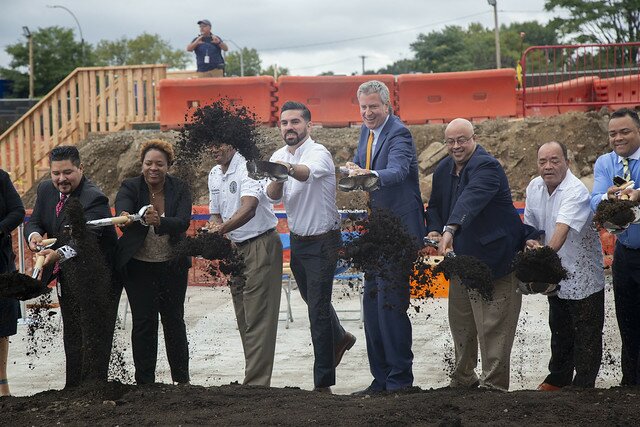
Mayor de Blasio & others break ground for a new East New York school (photo: John McCarten/City Council)
By Samantha Handler
Originally published in the Gotham Gazette on July 16, 2019
Some days, it can be hard for Arthur Goldstein to walk down the hallway of Francis Lewis High School in Queens, where he teaches English as a second language. Goldstein’s school is one of 25 overcrowded schools in the 26th school district, and has a utilization rate of 207 percent, according to a 2018 Department of Education report.
“There are some days when I think I’m going to go to this office and I turn around and walk to another office because it’s just too much work to get through walking down the hall that way,” Goldstein said. “I don’t know if you can even imagine that, but that’s happened to me more than once.”
Francis Lewis High School has a capacity of about 2,400 but enrolls closer to 4,600, Goldstien said. Those students are some of about 520,000 students — nearly half the city’s school population — in the city who attend an overcrowded, also known as over-utilized, school, according to a Citizens Budget Commission (CBC) reportreleased July 9. Those students attend roughly 618 schools, with the worst overcrowding in Brooklyn, Queens, and the central Bronx. Overall, there are roughly 1.1 million students in 1,840 schools in 32 school districts across the five boroughs, according to the Department of Education.
While the CBC report said crowding may lessen as enrollment citywide declines and, overall, the number of crowded school buildings has declined by 31 since 2015, others have expressed concern that the problem will get worse because the current need is already greater than the 83,000 seats the Department of Education has identified to be built to reduce crowding. In 2017, Mayor Bill de Blasio added 57,000 seats to the 2015-2019 capital plan to meet the 83,000 need seat estimate.
The new plan also includes $180 million for the removal of Transportable Classroom Units — known as TCUs or trailers — where some students at crowded buildings may be receiving instruction. In 2018, it was estimated that about 8,000 students learned in trailers, and then-schools Chancellor Carmen Farina said the DOE had removed 159 out of 354 total trailers and had plans to remove 75 more. In 2003, Mayor Michael Bloomberg’s capital plan projected that all TCUs would be able to be removed, and he promised that would be completed by 2012.
Former state Assembly Speaker Sheldon Silver had in 2014 urged de Blasio to prioritize the removal of trailers and set aside some of the $800 million the city received from the Smart Schools Act, which allocated funds for districts to upgrade technology, increase pre-kindergarten capacity, and get rid of trailers.
Chalkbeat reported at the time that lawmakers had doubts that removing trailers was a priority of the de Blasio administration, as a DOE official said at a hearing earlier that year that trailers could be used to expand capacity for pre-K, de Blasio’s top campaign promise and mayoral priority. De Blaiso said at a press conference at the time that he will keep prioritizing the issue in his capital plan, as in 2014 his administration allocated $405 million toward removing TCUs.
“I don’t want kids in trailers,” de Blaiso said at the press conference. “I want to move aggressively to get them out of trailers. We know that will take some time, but we’re committed to it. We’re also committed to putting in new facilities in most overcrowded areas.”
Now, several years later, advocacy groups like Class Size Matters and City Council Members like Daniel Dromm say the new city capital plan — which includes nearly $8.8 billion for school capacity projects to be started over the next five years — does not have an updated estimate of the need for seats since the 2015-2019 capital plan as residential development, rezoning projects, and other trends will change the need in certain sub-districts.
“It’s very suspicious,” said Leonie Haimson, the executive director of Class Size Matters, a nonprofit advocacy organization. “They claim to be building all the seats that are necessary, but that’s based upon an estimate that is many years old.”
Overcrowding occurs in pockets around the city with crowded buildings in each district of each borough, but CBC research associate Riley Edwards, who wrote the new school capacity report, said there are enough seats currently for all New York City students, and the key to thinking about alleviating school overcrowding is more aggressively pursuing strategies other than school construction.
Edwards said most districts actually have an excess of seats, and the severe overcrowding occurs in sub-districts, with nine of 32 districts — five in Queens, two in Brooklyn, one in the Bronx, and one on Staten Island — packed with more students than their target capacity.
Other myths about school overcrowding, as detailed in a 2016 CBC report also authored by Edwards, are that middle and high school students face the worst crowding problems — it’s actually elementary school students — and that plans to build new schools will solve the problem. The new report says the DOE needs to focus on other strategies it already uses, such as rezoning, changing admissions policies, repurposing seats, and programming.
“It does take a long time for the city to site and build a new school,” Edwards said. “There’s only so much available land in the city and a limited amount appropriate for school buildings.”
According to the Independent Budget Office, Queens’ District 26 ranked as the third-most crowded school district with a utilization rate of 109 percent for the 2017-2018 school year, behind District 25 in Queens, and District 20 in Brooklyn, which both had over 121 percent. However, Dromm said district- or borough-wide numbers do not reflect the “tremendous” overcrowding that occurs at the sub-district level in individual schools.
According to Class Size Matters, the average class size for K-12 schools in New York City during the 2018-2019 school year was 26, almost no change from 2014-2015 when the last capital plan was proposed. The average class size in the United States is 21, according to the Office for Economic Cooperation and Development. Haimson said over 330,000 students in the city were in classes of 30 or more.
While some research shows that reducing class sizes may have small benefits at best, Haimson said ultimately larger class sizes are detrimental for students.
“There’s a huge amount of rigorous research that shows the larger the class, the less learning goes on,” Haimson said. “There are also a lot of other negative effects of large class sizes. Kids become less engaged, they’re more likely to get held back, they’re more likely to get referred to special education, and they’re more likely to have disciplinary problems.”
Dromm, now the Council’s finance chair and previously its education committee chair, said during the 25 years he was teaching at P.S.199 in Queens’ District 24 he saw the crowding getting worse each year.
“I remember a day when the janitors came into the school, and they opened the maintenance closet right outside the staff room,” Dromm said. “They took out the pitchfork, they took out the rake, they took out the shovel, and they threw up a coat of paint. They turned that into the speech classroom. That’s how bad some of the situations are in some of the schools.”
To address the issue, the city Department of Education’s new $17 billion five-year capital plan for 2020-2024 proposes funding to create 57,000 new school seats across all school districts, with about half expected to be completed no later than the start of the 2025-2026 school year, according to the city’s Independent Budget Office. The IBO predicts that all of the seats would be completed by 2028.
The plan sets aside $8.8 billion for capacity issues, including $7.9 billion for 57,000 new school seats in 88 new buildings and $150 million for class size reduction programs, which the DOE described as “increasing the number of school options available to students.” The DOE plan outlines the Class Size Reduction Program as building additions or new school buildings near buildings that have a high rate of overutilization, use trailers, are geographically isolated, or has a recognized seat-need that has not been funded.
“We’ll continue to build on these investments and work with school communities to meet their needs,” Isabelle Boundy, an assistant press secretary at the Department of Education, said in a statement to Gotham Gazette.
In 2003, following a lawsuit that claimed the state’s school funding system underfunded the city’s public schools, a New York Supreme Court concluded that for New York City students to receive their constitutional right to a sound basic education, more equitable funding was needed to reduce class sizes. At the time, the average class size for grades 4 through 8 was 25, and Contracts for Excellence — the nonprofit advocacy organization that filed the lawsuit — said class sizes needed to be just slightly lower, around 24.
Four years later, the state passed a law called Contracts for Excellence that partly required districts to put funds toward reducing class size and required New York City to reduce class sizes across all grades to specific goals — such as reducing 4 through 8 class sizes to 23 by 2011 — over the next five years.
Since 2007, about 93,000 school seats have been built, according to CBC, but Class Size Matters says class sizes have gone up and are “still significantly larger” than in 2003. Kindergarten class sizes have risen from an average of 21 in 2007 to 24 in 2019, though the Contracts for Excellence target was around 20.
Class Size Matters joined a group of parents and other advocacy groups in April 2018 in filing a lawsuit against city schools Chancellor Richard Carranza, the DOE, and state education Commissioner MaryEllen Elia to demand the city reduce class sizes. The court ruled in 2018 it was up to the commissioner to decide, and she said in 2017 the class size requirements in the Contracts for Excellence law had expired years ago, though Class Size Matters charges that the law is still in full effect. The plaintiffs are now appealing the decision and arguments are expected later this summer.
Meanwhile, the city continues to build new school seats to try to relieve crowding issues, but does not have to follow the guidelines for class size in the Contracts for Excellence law.
At a City Council hearing in December, Dromm said while the investment in 57,000 new seats included in the new capital plan will bring the total number of seats constructed since the start of the last five-year plan to a “historic” 83,000 seats, he said the DOE did not include a new, recalculated number of seats needed in 2024.
He said the 83,000 seats fulfills a commitment the mayor made in 2017 to fully fund the identified seat need by 2025, but there is disagreement over whether that number will remain years later by the end of the new five-year plan in 2024. Shino Tanikawa, the co-chair of the city’s Education Council Consortium, a body of elected parent leaders, said even though the mayor added more seats to the plan, the city is “always behind” the need.
In 2015, the city rejected a recommendation from the Blue Book Working Group — which was formed to make the DOE’s Enrollment, Capacity, and Utilization report, commonly known as the Blue Book, more accurate — to include the class size standards set in the Contracts for Excellence law in the Blue Book calculations for capacity and utilization. Though, the DOE did remove trailers from capacity calculations, decreasing the capacity of those schools.
Tanikawa, who was a member of the group, said the DOE should use aspirational class sizes to calculate, but instead the report is calculated using class sizes that are too large. For grades 9 through 12, the Blue Book uses a target class size of 30, despite the 2007 goal of an average class size of 25 for those grade-levels, according to the city’s Planning to Learn report from 2018. The Blue Book uses a higher target class size than the goals set in 2007 for all grades except for Kindergarten through 3.
“To many of the advocates on the working group that was the most important recommendation we made,” Tanikawa said. “And that was the one that was rejected.”
The 83,000-seat estimate came from a DOE analysis in November 2017 and was released in the February 2018 version of the 2015-2019 five-year plan. Class Size Matters estimates that the need is at least 100,000 seats based on the number of schools that are currently overcrowded, the likelihood of enrollment growth in parts of the city, and the need for class size reduction.
“I believe that they’re right,” Dromm told Gotham Gazette of Class Size Matters’ estimate. “Seat need is probably closer to 100,000, and the administration’s plan does not really reflect that. They claim that they put 57,000 seats into the budget this year, but still it doesn’t really reflect the need we feel is out there.”
The DOE predicts a decline of 4 percent enrollment, down to about 881,000 students, across public schools (the projection excludes enrollment in non-DOE spaces, charter schools, and District 75) by 2022-2023, though Dromm said residential construction, rezoning efforts, and overall city population growth are not adequately addressed in the plan. Haimson said demographic trends are difficult to predict and that there may be less overcrowding due to population shifts in certain areas over time, but the city’s population is growing fast.
Enrollment has declined over the past decade across the United States due to falling birth rates, but CBC has also reported that enrollment may increase in already crowded districts.
The city’s population is expected to grow from 8.6 million in 2019 to 9 million in 2040, with the Bronx and Brooklyn expected to grow at the largest percentages, according to the city’s population projections.
“More and more families are choosing to stay in the city when they have children,” Haimson said. “And the mayor’s continuing to encourage development at any cost.”
When the city has undergone large-scale neighborhood rezonings, such as the ones for the Jerome Avenue corridor in the Bronx and East New York in Brooklyn, the School Construction Authority works closely with the Department of City Planning to identify the projected school seat need for those areas, according to SCA President Lorraine Grillo’s comments at a Council hearing in December. Rezoning deals between the city and local Council members often include school seat considerations, sometimes including the construction of at least one new school, like in East New York.
The new five-year plan allocates funding for 6,000 seats within six rezoning areas projected to move ahead during that time: the Hudson Square rezoning and Hudson Yards in Manhattan; Crotona Park East/West Farms rezoning in the Bronx; Pacific Park, Greenpoint Landing, Domino Redevelopment and Albee Square in Brooklyn; and Halletts Point rezoning in Queens.
According to the city’s Rezoning Commitments Tracker, the construction for a 1,000-seat school in East New York (the first neighborhood rezoning passed under de Blasio) has begun, and commitments were made in the Jerome Avenue neighborhood plan for new elementary schools in Districts 9 and 10. Commitments for at least one new school were included in four out of the city’s five large-scale neighborhood rezoning plans, with the others slated to be completed by 2023.
Council Member Vanessa Gibson of the Bronx, who chairs the Council’s capital budget subcommittee and negotiated the Jerome Avenue rezoning, said at the December Council hearing she was “pleased” about the Jerome Avenue commitments but added that the city is frequently rezoning smaller areas, and every new construction will bring families with school-age children. Griillo said the SCA is informed of smaller rezonings and uses them to inform future projections.
“(There are) the larger neighborhoods that we have rezoned from East Harlem, East New York, Far Rockaway, Jerome in the Bronx, and Inwood, but on a monthly basis on a much smaller scale we pass out smaller rezonings every single month,” Gibson said at the hearing. “We are creating an incredible amount of housing.”
The recent CBC report said there are significant shortcomings in the school construction the DOE and SCA do undertake. Not all new school capacity is created to address overcrowding, according to the report, and not all new seats are built in districts with overcrowding.
While the DOE also projects by 2022-2023 an enrollment decrease of 7 percent in elementary schools, where CBC says nearly two-thirds of the seat need is, the mayor’s initiatives like universal pre-kindergarten have added additional pressure to already overcrowded schools, though some programs are located at separate sites not run by the DOE, Edwards said.
A majority of the 93,000 seats built since 2007 have been for elementary school students, but more than 3,700 of those seats were built in districts with a “relatively low utilization,” according to the report.
Dromm said the DOE has allocated seats for districts they say have not received seats “in a while” though the need is greater in other districts. He said for District 24, the DOE has recognized that around 4,000 seats are needed to address crowding issues there, but those seats were not funded in the new five-year plan and were distributed to other areas.
At a council hearing in December, Grillo said more seats were added in District 24 than any other district in the city, so the funding for those seats were reallocated to districts that had not yet received additional seats.
“But District 24 remains one of the top districts for seat need,” Dromm said. “They’re still not addressing the areas where the seat need is the greatest, and that’s concerning to me.”
Additionally, the CBC report said the city has allocated too many seats for high schools, whose overcrowding problems could be solved by utilizing the surplus of high school seats and changing high school admissions practices.
Edwards said the city actually has more seats than students — the shortage of seats in crowded high schools, according to the CBC report, is about 32,000 whereas there’s about 65,000 unused seats at high schools — and there are ways the city can maximize that space.
However, the IBO said in testimony to the Council in 2015 that using the unused seats to alleviate overcrowding is difficult because changing admissions policies can be a contentious topic, the extra seats span across boroughs so the potential for change is limited to a few areas of the city, and DOE policies like universal pre-K will continue to put capacity pressure on buildings.
In the CBC report, Edwards outlined four ways the DOE can address overcrowding that are less expensive and more efficient than school construction, which takes an average of 41 months from the start of design to the end of construction. The DOE already uses these alternative strategies to reduce overcrowding — rezoning, repurposing seats, changing admission policies, and programming — but the report said they are “underutilized” while school construction is the main method.
According to an April 2019 DOE report on space overutilization in schools, the decline in overcrowded buildings from 646 in 2015 to 615 in 2018 was due to a combination of new capacity, resiting, facility upgrades, and new facilities.
According to CBC, in 2017, 42 high schools implemented “split-session” scheduling, which allows more than the traditional eight periods to be scheduled throughout the day; 43 schools were impacted by the rezoning of school districts; and 21 schools repurposed seats through re-siting to underutilized or new buildings. Some other schools received renovations or new facilities.
The CBC report says the DOE could rezone elementary schools or allow zones to overlap or be grouped together to use more seats at under-utilized schools. The report says the majority of the school district rezonings enacted between 2014 and 2017 were to accommodate the opening of a new school and implementing them more often to adjust incoming enrollment would be more effective.
According to the report, the city could also more frequently repurpose seats by truncating some schools and expanding others to relieve crowding. Another way to repurpose seats that has “substantial potential” to address the issue is converting administrative and non-school space to instructional rooms, CBC says.
While the report specifically says that buildings with multiple schools should share administrative offices to save space, some overcrowded schools have had to convert spaces like closets to create more room.
Enforcing enrollment capacity standards at high schools would reduce overcrowding at schools, like Francis Lewis in Queens, because there are enough seats citywide for high school students and those admissions are done on a citywide basis, the report said.
Tanikawa said because of the way the city funds schools — through the Fair Student Funding Act that allocates a fixed amount per student and adds funds if the school also serves students who are poor, struggling academically, have disabilities, or are learning English — there is an incentive for principals to take more students than a building is designed to hold.
“They don’t do it to be evil,” Tanikawa said. “They want to provide a robust, comprehensive education program and in order to do that principals are forced to take more students than they really should.”
Goldstein said it is “insane” that there is no limit to the number of students, which he said would be the best way to reduce overcrowding at Francis Lewis. Instead, the DOE plans to build an annex by 2021 which will add about 10 to 15 classrooms and replace the trailers the school currently uses.
Goldstein is his high school’s United Federation of Teachers chapter leader, and he said though the UFT has guidelines for class size, there is no upper enrollment limit for neighborhood schools like Francis Lewis.
He said he taught in a trailer for 12 years and taught in a half-sized classroom last year, which posed challenges ranging from preventing students from cheating to just getting around the room. Goldstein said he hopes they can eventually get rid of the trailers, but he fears that even with extra classrooms from the annex will not be enough.
“It will be good,” Goldstein said. “Will it be perfect? No it won’t be perfect.”
Read more here.
